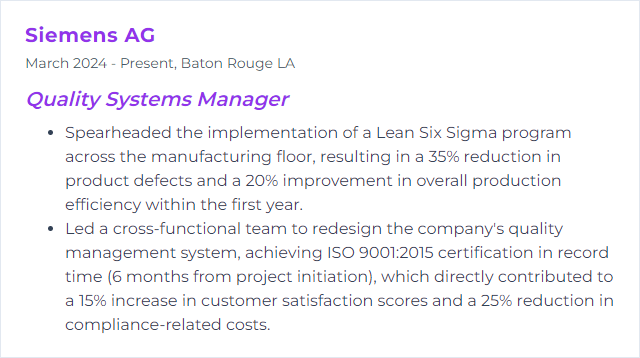Top 12 Quality Systems Manager Skills to Put on Your Resume
To excel as a Quality Systems Manager, incorporating a blend of technical expertise and soft skills into your resume is essential. Highlighting these skills showcases your ability to oversee quality systems effectively, ensuring products meet both customer expectations and regulatory standards.
Quality Systems Manager Skills
- ISO 9001
- Lean Six Sigma
- CAPA (Corrective and Preventive Action)
- Auditing Techniques
- Risk Management
- SAP Quality Module
- Statistical Process Control (SPC)
- Quality Management Systems (QMS)
- FMEA (Failure Mode and Effects Analysis)
- GMP (Good Manufacturing Practices)
- Root Cause Analysis
- Continuous Improvement
1. ISO 9001
ISO 9001 is an international standard for quality management systems (QMS), outlining criteria to ensure consistency in providing products and services that meet customer and regulatory requirements, thereby enhancing customer satisfaction. It emphasizes process approach, risk-based thinking, and continual improvement. For a Quality Systems Manager, it serves as a framework to guide and sharpen organizational processes and operational efficiency.
Why It's Important
ISO 9001 provides a structured system for managing quality, ensuring consistent outcomes, stronger customer satisfaction, and an engine for continuous improvement—core responsibilities for a Quality Systems Manager.
How to Improve ISO 9001 Skills
Strengthening ISO 9001 performance calls for focus, rhythm, and clear ownership:
Conduct a gap analysis: Compare current practice to ISO 9001:2015 requirements; prioritize high-risk gaps first.
Engage employees: Train, communicate, and involve teams in process design and problem-solving. Quality thrives on participation.
Optimize processes: Map end-to-end flows, remove waste, simplify handoffs, and standardize work instructions.
Run PDCA cycles: Plan improvements, pilot them, check results, then scale and control.
Listen to customers: Collect feedback, complaints, and NPS-type insights; translate them into corrective and preventive actions.
Audit risk-based: Schedule internal audits with ISO 19011 guidance in mind; target high-risk processes more frequently.
Hold management reviews: Review QMS performance, risks, opportunities, and resources; assign actions with due dates.
Use quality tools: Six Sigma, Kaizen, 5S, control plans, and dashboards to sustain gains.
How to Display ISO 9001 Skills on Your Resume

2. Lean Six Sigma
Lean Six Sigma blends Lean waste reduction with Six Sigma variation reduction to tighten processes, improve quality, and boost productivity. For a Quality Systems Manager, it’s a practical playbook to cut defects, cycle time, and cost—while lifting customer value.
Why It's Important
It gives a repeatable, data-driven way to solve problems, align teams, and sustain improvements that matter to customers and the business.
How to Improve Lean Six Sigma Skills
Amplify impact with disciplined execution and smart support:
Build capability: Provide role-based training (Yellow/Green/Black Belt) and coaching; codify standards.
Practice Kaizen: Encourage small, frequent improvements alongside larger DMAIC projects.
Use DMAIC rigor: Define the problem clearly, measure well, analyze root causes, improve with pilots, and control with SPC and SOPs.
Center on the customer: Capture Voice of the Customer and tie CTQs to metrics and project charters.
Go cross-functional: Blend operations, engineering, quality, and supply chain to break bottlenecks.
Leverage technology: Use tools for process mapping, data analysis, and project tracking to speed decisions.
Review outcomes: Track benefits, verify controls hold, and replicate wins.
How to Display Lean Six Sigma Skills on Your Resume
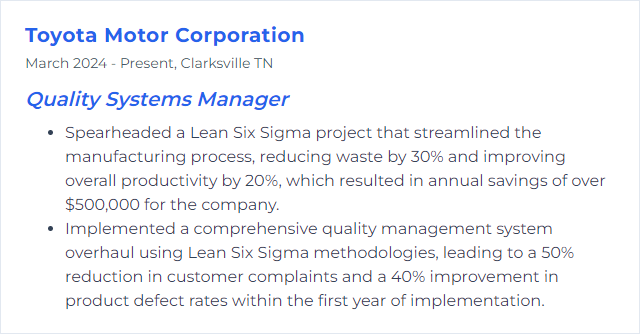
3. CAPA (Corrective and Preventive Action)
CAPA is a structured process to investigate issues, fix them, and prevent recurrence. It binds root cause analysis with effective actions, documentation, verification, and continuous learning.
Why It's Important
CAPA reduces repeat problems, drives compliance, and protects customers—lowering risk and cost while lifting confidence in your products and processes.
How to Improve CAPA (Corrective and Preventive Action) Skills
Make CAPA sharp, fast, and reliable:
Deep root cause analysis: Apply 5 Whys, Ishikawa, fault tree, and verification of causes before acting.
Risk-based prioritization: Use FMEA and risk scoring to focus on high-severity, high-occurrence items first.
Clear ownership and training: Define roles, due dates, and escalation; train teams on CAPA workflows and evidence requirements.
Data-driven decisions: Use Pareto charts, trend analyses, and control charts to spot patterns and validate improvements.
Effectiveness checks: Confirm actions remove causes, not symptoms; monitor for reoccurrence.
Strong documentation: Maintain end-to-end traceability—problem statement, investigation, actions, verification, closure.
Review cycles: Hold routine CAPA boards; harvest lessons learned and feed them into procedures, training, and design updates.
How to Display CAPA (Corrective and Preventive Action) Skills on Your Resume
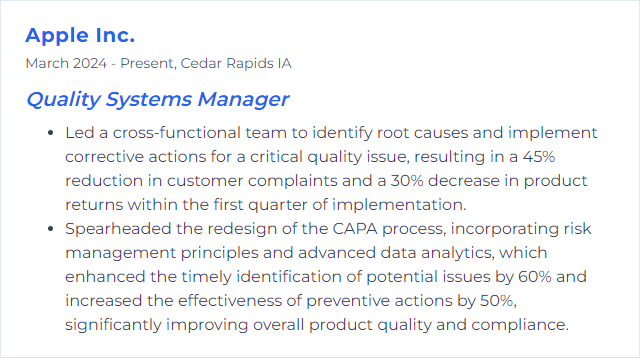
4. Auditing Techniques
Auditing techniques are structured methods—planning, sampling, interviews, observation, and reporting—used to test the health, compliance, and effectiveness of a quality management system.
Why It's Important
Audits spotlight gaps before they bite, verify controls, and guide improvements that keep standards intact and customers protected.
How to Improve Auditing Techniques Skills
Elevate audit quality with precision and fairness:
Follow ISO 19011 principles: Competence, integrity, evidence-based conclusions, and risk-based audit programs.
Plan smart: Define scope, criteria, methods, and sampling; tailor to process risk and performance history.
Use digital tools: Checklists, workflows, evidence capture, and dashboards reduce errors and speed reporting.
Interview well: Ask open questions, verify with records, and observe the work as performed.
Drive corrective action: Write clear nonconformities, agree on root cause analysis expectations, and verify closures.
Collect feedback: After each audit, debrief what worked and what didn’t; adjust the audit program accordingly.
How to Display Auditing Techniques Skills on Your Resume
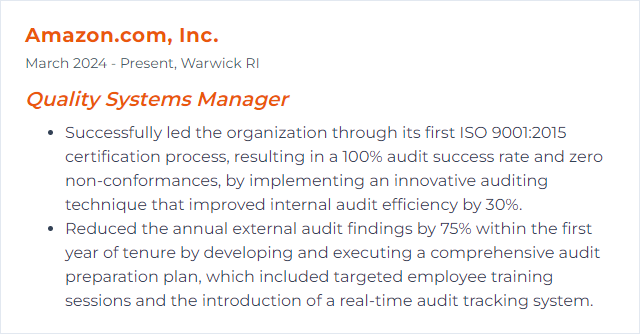
5. Risk Management
Risk management identifies, evaluates, and controls threats to quality, compliance, and performance, embedding proactive thinking into daily operations.
Why It's Important
It prevents surprises, protects customers, and directs resources to where failure would hurt most—supporting both compliance and business resilience.
How to Improve Risk Management Skills
Make risk work practical and visible:
Identify systematically: Use FMEA, hazard analyses, SWOT, and process maps to surface risks across the lifecycle.
Assess consistently: Rate severity, occurrence, and detection; align with an enterprise risk framework such as ISO 31000 where appropriate.
Mitigate effectively: Redesign processes, add mistake-proofing, strengthen controls, and upgrade training.
Monitor continuously: Apply PDCA; review leading indicators and near-misses, not just lagging defects.
Document and communicate: Keep risk registers current; share top risks and actions with stakeholders.
Use enabling tech: Centralize risk data, alerts, and action tracking to maintain momentum.
How to Display Risk Management Skills on Your Resume
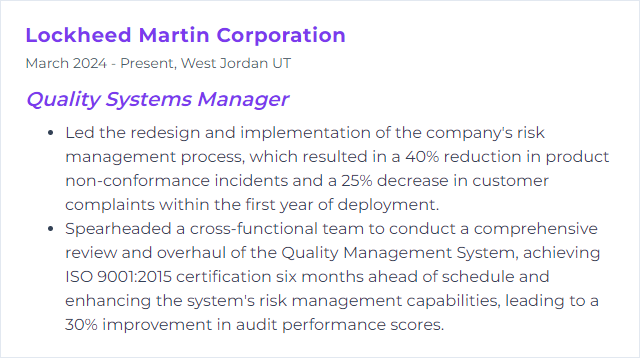
6. SAP Quality Module
The SAP Quality Management (QM) module—within SAP ERP and SAP S/4HANA—supports planning, execution, and tracking of inspections, nonconformances, and corrective actions. It ties quality into procurement, manufacturing, and logistics for end-to-end visibility.
Why It's Important
It embeds quality controls where work happens, strengthens compliance, and provides data for targeted improvements—key levers for a Quality Systems Manager.
How to Improve SAP Quality Module Skills
Unlock value by fitting the tool to your process, not the other way around:
Customize thoughtfully: Configure inspection plans, catalogs, usage decisions, notifications, and workflows to match real operations.
Integrate tightly: Connect QM with Materials Management (MM), Production Planning (PP), Plant Maintenance (PM), and EHS for a single source of truth.
Train by role: Teach inspectors, planners, and reviewers exactly what they need; use simulations and SOPs.
Standardize data: Master data discipline (materials, characteristics, code groups) prevents noise and rework.
Exploit analytics: Use dashboards and KPIs to catch trends, trigger CAPAs, and verify effectiveness.
Stay current: Track release updates and refine processes as features evolve, especially in S/4HANA.
How to Display SAP Quality Module Skills on Your Resume
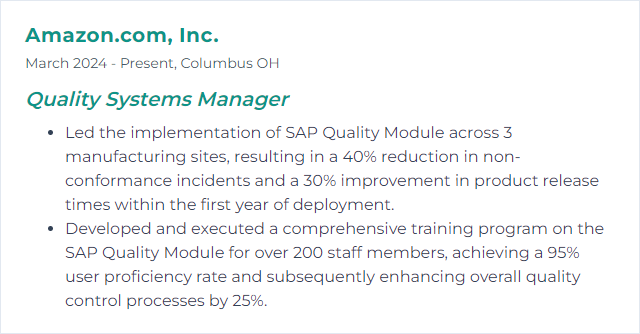
7. Statistical Process Control (SPC)
SPC uses statistical tools—especially control charts—to monitor process variation, detect special causes, and keep processes stable and capable.
Why It's Important
It cuts defects before they ship, lowers scrap, and drives predictable performance.
How to Improve Statistical Process Control (SPC) Skills
Make SPC actionable and trusted:
Train for understanding: Explain variation, control limits, capability (Cp/Cpk), and what actions to take.
Standardize data collection: Calibrate gauges (MSA), define sampling plans, and lock down units and frequency.
Use real-time charts: Alert operators immediately; define clear out-of-control action plans.
Target root causes: When signals fire, investigate with 5 Whys and verify fixes with the chart.
Review routinely: Reassess control plans and charts as products, processes, or volumes change.
Connect to improvement: Feed SPC findings into CAPA and Lean projects to prevent recurrence.
How to Display Statistical Process Control (SPC) Skills on Your Resume
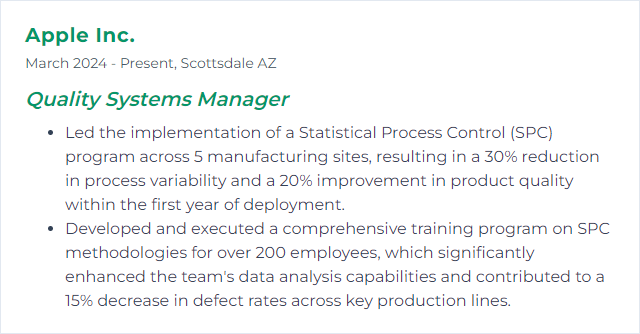
8. Quality Management Systems (QMS)
A QMS is the set of policies, processes, and procedures that enable an organization to consistently meet requirements and improve. It’s the framework a Quality Systems Manager stewards to align people, process, and data.
Why It's Important
It turns quality from a set of tasks into a management system—repeatable, auditable, and scalable.
How to Improve Quality Management Systems (QMS) Skills
Build a system that breathes and learns:
Run a candid gap analysis: Compare to ISO 9001:2015 and industry/regulatory needs; size the effort and risks.
Engage stakeholders: Involve process owners, customers, and suppliers; map expectations and handoffs.
Apply PDCA: Treat improvements as experiments; document, test, and standardize.
Strengthen training: Role-based curricula, competency checks, and refreshers tied to changes.
Adopt QMS software: Centralize document control, change control, CAPA, audits, and training records.
Measure what matters: Define KPIs tied to quality objectives and customer outcomes; review them rhythmically.
Audit with intent: Use ISO 19011 guidance; calibrate auditor competence and sampling depth to risk.
Hold management reviews: Evaluate performance, risks, resources, and opportunities; assign actions and track them.
How to Display Quality Management Systems (QMS) Skills on Your Resume
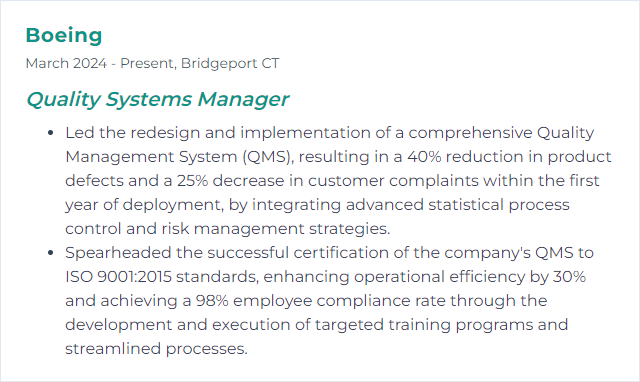
9. FMEA (Failure Mode and Effects Analysis)
FMEA is a structured method to identify how a product or process might fail, estimate risk, and prioritize actions to prevent or mitigate those failures.
Why It's Important
It moves risk upstream—preventing issues before they reach customers and guiding design and process robustness.
How to Improve FMEA (Failure Mode and Effects Analysis) Skills
Make FMEA practical and current:
Cross-functional collaboration: Include design, manufacturing, quality, service, and suppliers to capture real risks.
Train on methodology: Align on process steps, rating scales, and evidence standards.
Use historical data: Feed in field returns, NCRs, SPC signals, and warranty claims to inform failure modes.
Adopt supportive software: Standardize templates, approvals, and linkages to control plans.
Prioritize with AP: Use Action Priority (AIAG-VDA FMEA) rather than legacy RPN to focus actions where they matter most.
Keep it living: Update after design/process changes, customer feedback, or incident learnings.
Integrate with other tools: Tie FMEAs to control plans, work instructions, MSA, and SPC.
How to Display FMEA (Failure Mode and Effects Analysis) Skills on Your Resume
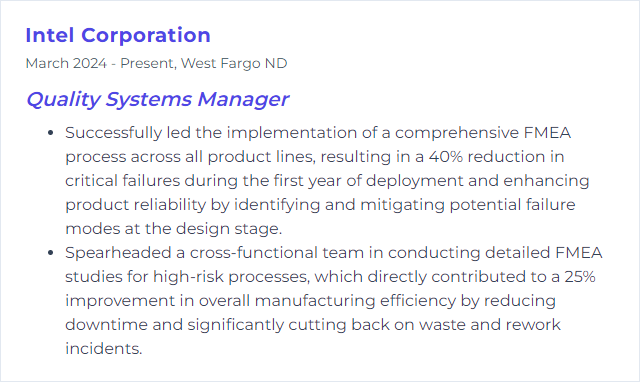
10. GMP (Good Manufacturing Practices)
GMP is a comprehensive system of practices that ensures products are consistently made and controlled to quality standards. It spans premises, equipment, documentation, training, production, QC, and change control—especially vital in regulated industries.
Why It's Important
It protects patients and consumers, prevents contamination and mix-ups, and anchors compliance—safeguarding both health and reputation.
How to Improve GMP (Good Manufacturing Practices) Skills
Embed GMP into everyday behaviors:
Stay aligned with regulations: Monitor applicable requirements and guidance; map them to your QMS and SOPs.
Train and qualify: Role-based GMP training, ongoing refreshers, and documented competency checks.
Document with integrity: Robust SOPs, batch records, change controls; follow data integrity principles (ALCOA+).
Strengthen QA and QC: Risk-based sampling, method validation, stability programs, and independent batch disposition.
Audit and self-inspect: Routine internal audits and shop-floor walkthroughs; close gaps with CAPA.
Control suppliers: Qualify, audit, and monitor suppliers; use quality agreements and incoming inspection plans.
Leverage technology: Digital batch records, eQMS, and traceability systems to reduce errors and improve visibility.
Manage changes: Formal change control with impact assessments and effectiveness checks.
How to Display GMP (Good Manufacturing Practices) Skills on Your Resume
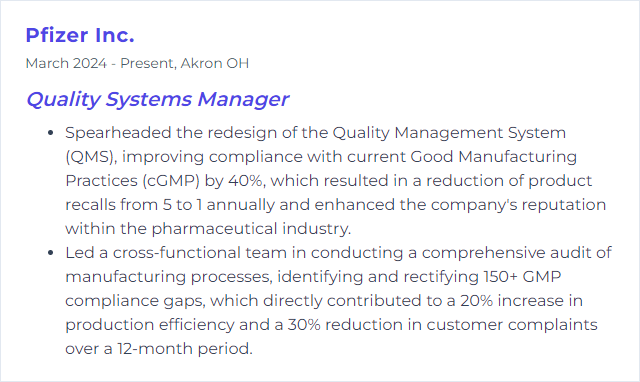
11. Root Cause Analysis
Root Cause Analysis (RCA) is a disciplined approach to uncover the underlying causes of a problem and implement solutions that prevent it from recurring.
Why It's Important
RCA stops firefighting. It eliminates repeat defects, strengthens processes, and cements learning across the organization.
How to Improve Root Cause Analysis Skills
Make RCA evidence-heavy and outcome-focused:
Train on methods: 5 Whys, Fishbone, fault tree, 8D, and cause mapping; practice with real cases.
Use solid data: Time-stamped logs, MSA-validated measurements, and stratified analyses to avoid false trails.
Form cross-functional teams: Blend process owners and front-line experts; challenge assumptions.
Verify causes: Recreate the issue or use experiments to confirm cause–effect before fixing.
Implement and check: Tie corrective actions to verified causes; define effectiveness criteria and monitor.
Standardize: Templates, checklists, and review gates increase consistency and quality of investigations.
Share lessons learned: Publish findings and update SOPs, training, and design rules accordingly.
How to Display Root Cause Analysis Skills on Your Resume
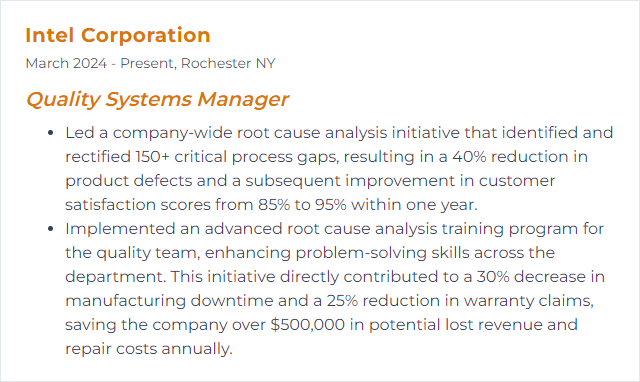
12. Continuous Improvement
Continuous improvement is the relentless pursuit of better—incremental and breakthrough—across products, services, and processes.
Why It's Important
It keeps quality moving forward, strips waste, and adapts the organization to shifting customer needs and regulations.
How to Improve Continuous Improvement Skills
Turn improvement into habit:
Engage the team: Open idea channels, recognize contributions, and empower rapid experiments.
Blend methods: Use Lean, Six Sigma, and Agile practices where they fit; avoid dogma.
Digitize insights: Track ideas, projects, KPIs, and benefits; visualize flow and bottlenecks.
Invest in learning: Ongoing training, communities of practice, and coaching to build muscle.
Set SMART goals: Clear targets, owners, timelines, and measures of success.
Broadcast results: Share before/after metrics; scale what works, retire what doesn’t.
How to Display Continuous Improvement Skills on Your Resume
